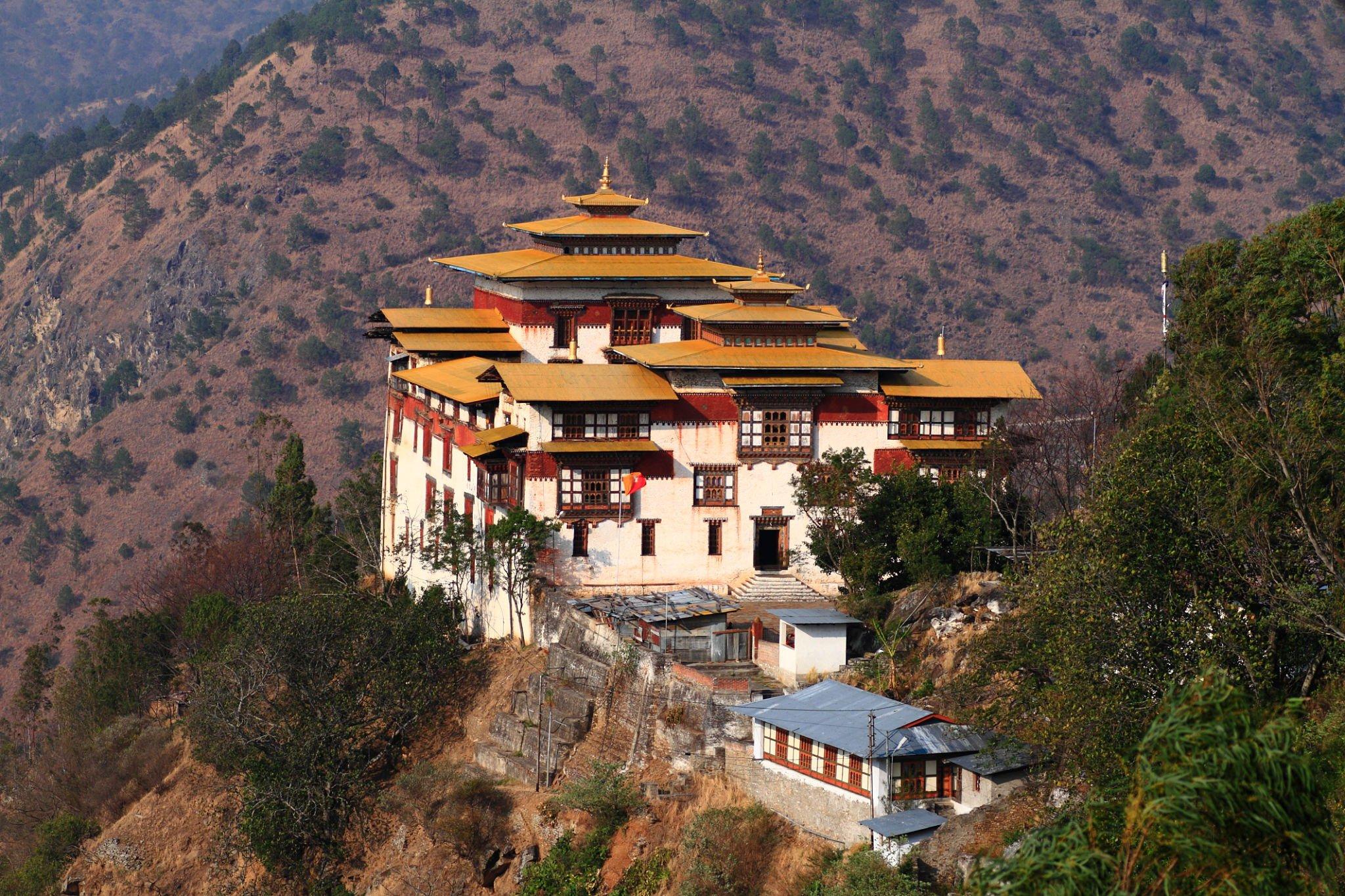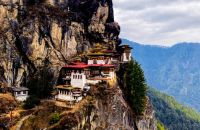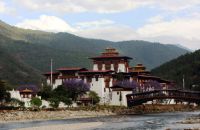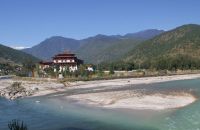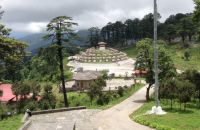Talk with our local travel specialist who can help organize your trip.
Exploring Bhutan's Treasures: A 5-Day Must-Do Guide
If there's one destination in Asia that can be regarded as exclusive and unique, it is Bhutan. Nestled deep in the eastern Himalayas, Bhutan is an amazing country that prioritizes the happiness of its people over material wealth. In addition, it is one of the most environmentally friendly countries, producing more oxygen than it consumes.
Bhutan's forests cover more than seventy percent of its land area, making it the ideal destination for nature lovers. Connoisseurs of Buddhist art and culture will also find this a great destination.
A 5-day trip to Bhutan will let you explore most of the attractions that Bhutan is famous for. You can base your travel around three Bhutanese cities: Paro, Thimphu, and Punakha. These cities are the economic, political, and cultural hubs of Bhutan.
The only international airport in the country is in Paro, while Thimphu and Punakha are the summer and winter capitals of the Je Khenpo (the religious head of Bhutan) and the monastic body. (This information is correct but I feel that flow of the sentence is not correct. Please tell your content write to do some correction)
Hike to secluded monasteries and shrines, drive past mist-covered mountain passes, tickle your taste buds with the fiery chili and cheese dishes, and rub shoulders with the betel nut chewing locals at the farmers market.
A trip to the Land of the Thunder Dragon is a unique experience, one that will leave you fascinated and mesmerized. So what can you do on a 5-day visit to Bhutan?
Day 1 and 2: Thimphu
Thimphu, the capital of Bhutan, is the most important city in Bhutan. In this sparsely populated country, Thimphu has the highest population. The city is filled with government offices, ancient castles, monasteries, and other grand tourist attractions.
After landing at Paro International Airport, you can take an hour's drive to the capital city and kick off your tour by discovering the charms of this beautiful city. The list of not-to-be-missed attractions and experiences are:
Attractions in Thimphu
Memorial Chorten
The Memorial Chorten is a beautiful white stupa built in memory of the third King of Bhutan, Jigme Dorje Wangchuck, who introduced Bhutan to the modern world. He is largely credited with bringing in positive reforms and paving the way for development in the country.
The Chorten lies in the middle of the city and is visited by locals throughout the day. Inside the stupa are paintings of the late King and Buddhist religious artifacts.
National Textile Museum
Bhutan has a rich textile heritage. The National Textile Museum, which is part of the Royal Textile Academy, showcases the array of hand-woven textiles and designs found in the country.
The museum also has on display the ceremonial clothes worn by royalty, including the wedding dresses of the fourth King of Bhutan, Jigme Singye Wanchuck, and his four brides.
One can also find a collection of traditional dresses worn by different generations of Bhutan's royal family at the museum.
The National Textile Museum spreads over four floors and exhibits the elaborate weaving techniques and traditional handlooms used in weaving traditional fabrics. The Bhutanese take pride in wearing their traditional costume, and this museum showcases a piece of their national pride.
Buddha Dordenma
The Buddha Dordenma Statue is one of the largest statues of Lord Buddha in the world. The statue sits on a hill known as Kuenselpodrang that overlooks Thimphu Valley. The gigantic bronze statue is an amazing work of art.
The statue is cast in pure bronze and rises to a height of 51.5 meters. Inside the statue are 125,000 more miniature statues of Lord Buddha.
The base of the statue is a three-story meditation hall and temple. One can enjoy stunning views of the Himalayan mountains and the Thimphu Valley from the location.
Tashichho Dzong
The most important structure in Thimphu is certainly the majestic Tashichho Dzong. This fortress was a strong line of defense when invaders from the north tried to attack Bhutan. Located close to the Wang Chhu River, the dzong was first built in the year 1216 by Lama Gyalwa Lahnangpa. The building was ravaged by fire twice and was rebuilt and renovated.
Spread over a large area, the dzong houses the offices of the King of Bhutan, the throne room, the secretariat and a monastery
Motithang Takin Preserve
Takin is the national animal of Bhutan. This animal is unique to this region and is not seen in other parts of the world. The Royal Takin Preserve protects and provides a home for this unique animal species. The animal looks partly like a cow, a buffalo, and a goat. According to local legend, takin was created by the Divine Madman (Drukpa Kuenley) with the leftover bones of a goat and a cow, when he was asked for a miracle.
Changkangkha Lakhang
Changkangkha Lakhang is an ancient Buddhist temple perched on a ridge on the outskirts of the main city. The temple was established in the twelfth century and is one of Bhutan's oldest Buddhist shrines. The main deity of this temple is Tamdrin, a protective deity and a manifestation of Avalokkiteshwara, or Chenrizeg.
Naming ceremonies for newly born babies in Thimphu are held at this temple. Locals believe that Tamdrin will protect and bless their newborn babies if they are brought here for the naming ceremony.
Folk Heritage Museum
The Folk Heritage Museum is housed in a traditional house and showcases the traditional artifacts used in Bhutanese homes. The museum offers you a peek into the rural lifestyle of the Bhutanese. The exhibits include farming tools, household utensils, wooden furniture, traditional baths, etc. The museum also has a restaurant where you can enjoy traditional Bhutanese food.
Thangthong Dewachen Nunnery
The Dewachen Nunnery, also known as Zilukha Nunnery, was established in the fifteenth century. Located on a peaceful site surrounded by pine trees, it is the only nunnery in Thimphu. The nunnery accommodates around sixty nuns who come from all over Bhutan to learn Buddhist teachings and lead an austere life.
National Institute for Zorig Chusum
At the National Institute of Zorig Chusum, you can witness students learning the 13 traditional arts of Bhutan - Shingzo (carpentry), Dozo (masonry), Lhazo (painting), Parzo (carving), Zingo (sculpting), Lugzo (bronze casting), Ginzo (blacksmithing), Troeko (jewelry making), Thagzo (weaving), Tsarzo (cane and bamboo weaving), Tsehemzo (tailoring and embroidery), Shagzo (woodturning), and Dezo (paper making).
You can visit the workshops and observe the students creating works of art from raw materials. There are gift items at the institute's gift shop where you can purchase items produced at the institute.
Bhutan Postal Museum
If you are into philately, you will love a visit to the Bhutan Postal Museum. The museum has five galleries that showcase the evolution of communication systems in Bhutan and the history of the country's postal services.
There are tableaus showing how runners were used to relay information and messages between towns and villages. An assortment of stamps issued over the years by the government are also exhibited at the museum. The museum offers personalized stamps to visitors for a small fee.
Dochula Pass
The Dochula Pass is one of the highest motorable mountain passes in Bhutan. The pass lies on the outskirts of Thimphu, on the way to Punakha.
One can enjoy a 360-degree view of the Bhutanese mountains and green hills from the pass. The pass is decorated with 108 memorial chortens dedicated to the fallen Bhutanese soldiers who lost their lives in the line of duty. The chortens were commissioned by the Queen Mother.
Must-try Experiences
Try Bhutanese Cuisine
Bhutanese cuisine is very different from that of its neighboring countries. The soul of Bhutanese food is the chilies, which are grown abundantly in the country, and cheese. Yak cheese and butter are used liberally in the local dishes.
Prepared with organic vegetables, red rice, and meat items, Bhutanese food is hearty, nutritious, and just right for the cold mountain climate.
On the list of must-try Bhutanese dishes are Ema datshi (chilies with cheese and butter), Shamu Datshi (mushrooms with cheese), Juma (milk and vegetable broth), Jasha Maru (chicken stew), Sikam (dried pork), Hoentay (buckwheat dumplings), Khur-le (buckwheat pancake), Gondo datshi (scrambled eggs with cheese and butter), Puta (buckwheat noodles), and different meat dishes with cheese (datshis).
Leaving Bhutan without drinking Suja or butter tea is a big no-no. You should certainly try the salty butter tea, which has a distinct taste.
Visit the Farmers Market
As eighty percent of the Bhutanese population is involved in farming and agriculture, the farmer's markets are important economic hubs. Famers from far-off villages bring their produce to sell at these markets.
The Centenary Farmers Market in Thimphu is an important place to buy organic produce from all over Bhutan. At this market, one can buy vegetables fresh from the farm, grains (red rice, barley, and maize), dairy products (yak cheese, butter, dehydrated cheese, or chugo), organic honey, dried meat, local fruits, local wine, etc.
It is a place where you can interact with the local farmers and practice a bit of the Dzongkha that you have picked up during your trip.
Traditional Paper Making
Close to the Centenary Farmers Market is a traditional paper-making factory, Jungshi Handmade Paper Factory. You can visit this factory and see for yourself how Bhutanese traditional paper, or Deh Soh, is made from the bark of Dekap and Daphne trees.
Traditional methods are used to make this beautiful paper, which is used by monks to write the Buddhist scriptures.
Nowadays, these handmade papers are exported to different countries in Europe, North America and Asia. Flowers, grasses, and dried chilies are used to add texture and decorate the handmade papers. You can also try your hand at papermaking and get your own customized paper.
Get your own personalized stamp
Yes, you heard it right! You can create your own personalized postal stamp in Bhutan. The Bhutan Postal Museum in Thimphu offers personalized postage stamps for a fee. You can choose a background and have your photo printed on the stamp. You will get 12 stamps for about 500 Ngultrum(Bhutanese currency).
The printed stamps are usable and can be used to post letters or postcards. The personalized stamps can be great keepsakes of your Bhutan trip.
Day 3: Punakha
Punakha is home to the most beautiful fortress in Bhutan, the Punakha Dzong. This beautiful city has a glorious past, as it was the first official capital of the country. It is still known as the winter capital of the monastic body.
Nestled beneath soaring hills and mountains, Punakha is a beautiful valley.
The city lies in a wide valley where the male and female rivers, Po Chhu and Mo Chhu, meet and flow freely. Surrounded by terraces of rice fields and ornately decorated wooden houses, Punakha is an idyllic destination.
While the city is famed for its natural beauty, it is also an important religious and political center.
Punakha was the venue for the coronation of the first monarch. It was also chosen as the site for the royal wedding of the fifth King of Bhutan. Compared to Thimphu, the city of Punakha is less busy, and life moves at a slower pace. The slow and peaceful vibe of the city is relaxing as well as calming.
Attractions in Punakha
Punakha Dzong - Punakha Dzong, or the Palace of Great Bliss, is a traditional castle fortress that lies at the confluence of two pristine Himalayan rivers, Po Chhu and Mo Chhu. The dzong is the administrative center of Punakha Dzonkhag and houses government offices, monasteries, and Buddhist shrines.
It is also the winter residence of Je Khenpo, the chief abbot of Bhutan.
This beautiful fortress lies at the confluence of the Po Chhu and Mo Chhu Rivers. The building holds the embalmed remains of the unifier of Bhutan, Zhabdrung Ngawang Namgyal and other Buddhist relics.
It is a royal tradition for Bhutanese kings to seek blessings from the Zhabdrung after coronation before starting their reign. Only the king, Je Khenpo, and the penlop are allowed to enter the chamber where the remains of Zhabdrung Namgyal are kept.
Some of the historic events held inside the Punakha Dzong include the coronation of Ugyen Wangchuk, the first hereditary monarch of Bhutan; the hosting of the First National Assembly; and more recently, the royal wedding of the fifth king of Bhutan.
The Punakha Dzong, with its spacious courtyards, also serves as the venue of the two biggest festivals in Punakha: Punakha Tsecchu and Punakha Drubchen.
Khamsum Yulley Chorten
The Khamsum Yulley Chorten was built to usher in peace and harmony the world over. The Chorten is built in the Bhutanese style of architecture and displays religious Buddhist art.
The three-storied of the Chorten are filled with statues of Lord Buddha, Padmasambhava, or Second Buddha, and other Buddhist deities.
From the terrace of the Chorten, one can enjoy breathtaking views of the Punakha Valley, dotted with rice fields and green hills. To reach the chorten, one has to cross the Mo Chhu River via a suspension bridge and walk across the rice fields.
After crossing the rice fields, take a steep path that climbs into a dense pine forest. Following the path, you will reach the chorten after a brisk climb of 40 minutes or 1 hour.
Chimi Lhakhang
The Chimi Lhakhang, or Fertility Temple, is an ancient temple dedicated to the Divine Madman, Drukpa Kuenley.He is known to have subjugated demons and wrought miracles using his flaming thunderbolt of wisdom.
The temple is a pilgrimage site for childless couples who seek blessings from the saint. A wooden phallus with a silver handle is used to bless people who visit the shrine.
The temple lies in a village where people have painted the walls of their houses with phalluses. The phalluses are symbols of Drukpa Kuenley's divine thunderbolt and are used to ward off evil spirits and negative energies from homes. Souvenir shops outside the temple sell small wooden phalluses as charms.
Must-try Experiences
Hike through Paddy Fields- Punakaha is a picturesque town filled with paddy fields and Himalayan rivers. To reach most of the sightseeing spots, one has to walk past paddy fields and cross suspension bridges built across glacial rivers. The natural environment is very peaceful and soothing.
The walk through rice paddies is an amazing experience. You will find many spots where you can shoot pictures and reels for Instagram.
Village Walk
Explore the Sopsokha Village, which lies close to Chimi Lakhang Temple. According to local legend, the Buddhist saint Drukpa Kuenley tried to subdue a demoness who lived in Dochula and killed children. She took the form of a dog and followed the saint to Sopsokha village.
Drukpa Kuenley captured the demoness and killed her at the site where Chimi Lakhang was built. The remains of the demoness were kept in a black stupa, which one can still see standing at the Chimi Lakhang temple's compound.
After the incident, the villagers of Sopsokha painted the walls of their homes and entrances with decorative phalluses depicting the phallus of the Mad Saint. Every house in this village is painted with phalluses, which makes it unique. The village lies in a scenic spot surrounded by rows of terraced fields and forested hills.
Day 4 and 5: Paro
Paro is a valley of myths and monasteries. This fertile valley is home to more than a hundred monasteries and temples. The most famous among them is the iconic Taktsang, or Tiger's Nest Monastery.
Paro also has the only international airport in the country. Surrounded by tall mountains and hills, Paro International Airport is one of the most beautiful as well as dangerous airports in the world. Only specially trained pilots are allowed to fly an aircraft into Paro International Airport.
Dotted with traditional wooden houses, terraced farms, and pine forests, Paro is the ideal destination for a peaceful vacation in the midst of nature.
Attractions in Paro
Taktsang Monastery
A visit to Paro is incomplete without a hike to Taktsang Monastery. The monastery is a sacred pilgrimage site for Buddhists, as Guru Padmasambhava is believed to have meditated here after traveling from Tibet on the back of a flying tigress.
He meditated at the spot where the Taktsang Monastery was built for 3 years, 3 months, and 3 days.
This iconic monastery is perched 900 meters above the valley floor, on the face of a rocky cliff. It lies at an altitude of 3200 meters and is one of the highest hiking destinations in Paro. The hike to the monastery involves walking past a thick forest of tall cedars and pines, decorated with colorful prayer flags.
The hiking trail is well maintained, and there are places to rest at intervals. Ponies are available for hire up to the halfway point, for those who want to skip the long ascent up the hill.
The hike begins at the car park and follows a steep hill. The trail goes past a woodland area covered with pine, fir, and tall cypress trees.The vibrant red, blue, white, yellow, and green colors of the prayer flags brighten up the trail.
There's a restaurant at the top, where one can get refreshments and enjoy a bird's-eye view of the Paro Valley. From this point, you walk along the hillside and take a staircase built on the side of a cliff.
You have to climb around 750 steps to reach the monastery. Cameras and bags are not allowed inside the monastery. You may can deposit your belongings at the monastery's entrance. Inside are a chapel and shrine dedicated to Guru Rinpoche.
You can light a butter lamp and send prayers to the Buddhist deities. After visiting the monastery, you can walk down via the same route. The descent is equally difficult, as it is steep downhill from the top.
Ringpung or Paro Dzong
Rinpung Dzong is one of the most majestic landmarks in Paro. Ringpung Dzong in Dzongkha means 'Fortress on a Heap of Jewels'. The fortress, which is also known as Paro Dzong, lies close to the Paro River.
The dzong was built in the seventeenth century by Zabdrung Namgyal to shelter the town's residents during Tibetan invasions. The present fortress is built on the site of an earlier building constructed by a Buddhist monk, Drung Drung Gya, in the sixteenth century.
The majestic fortress houses administrative offices and a monastery. There are about one hundred and sixty monks living in the monastery. Paro Tsecchu, the most important festival celebrated in the valley, is held in the courtyard of the Ringpung Dzong.
Ta Dzong or National Museum
The National Museum, or Ta Dzong, is a circular building that houses the National Museum. The dzong sits right above Ringpung Dzong. The Ta Dzong is a former watchtower built in the shape of a conch using only stones and wood.
No nails have been used in the construction of the tower. The tower is divided into seven stories. More than three thousand ancient artifacts are showcased inside the museum.
Kyichu Lakhang
Kyichu Lakhang is one of the oldest temples in Bhutan. According to local folklore, it was one of the one hundred and eight temples that were built overnight by the Tibetan emperor Songsten Gampo to subdue a demoness. The temple dates back to the seventh century and is one of the most ancient Buddhist shrines in the Himalayas.
For Bhutanese pilgrims, this is a sacred site, as Padmasambhava, or the Second Buddha, visited Kyichu Lakhang in the eighth century and meditated at the shrine. He is also believed to have hidden some Buddhist treasures, or termas, around the temple area.
The temple houses statues and religious relics. The most important treasure of this temple is the seventh-century statue of Jowo Shakyamuni.
Must-try Experiences
Village Homestay - Paro is dotted with rural farms and paddy fields. Enjoy an immersive cultural experience by staying with a local family at a farm. Staying with a local family will give you an insight into how common Bhutanese live. You can spend time with the family, helping them with their chores around the farm.
You can also taste authentic Bhutanese food during your homestay. Bhutanese cuisine is really unique, as a lot of cheese and chilies are used in the dishes.
Red rice, cheese, butter, and heaps of chili are included in every dish. If you are into spicy food, you will surely love Bhutanese food. Yak meat, pork, beef, and chicken are included in most of the dishes.
Traditional Stone Bath
You cannot depart from Bhutan without enjoying a traditional stone bath. The stone bath is especially relaxing after a tiring hike, like the one to Taktsang Monastery. The bath is prepared by using water from a river that is heated with hot stones and soaked in Artemisia leaves.
The leaves have medicinal properties and cure a lot of common ailments. The large river stones are roasted on an open fire, and once they are red hot, they are immersed in the tub. One can soak in the wooden tub for an hour or so, soaking up all the health-giving goodness of the stones (these stones are supposed to release minerals needed by the body) and medicinal leaves. You can also enjoy this kind of bath at a hotel spa or a hotspring.
Archery
Archery, or Dhaa, is the national sport of Bhutan. Traditionally, Bhutanese are very good archers, as archery has been a part of their lives for centuries.The bow and arrow were used as weapons to ward off enemies as well as to hunt for food. It's a recreational sport loved by both young and old people.
In every town and village, you will find an archery ground where people divide themselves into teams and compete. The target is placed at a distance of 100 or 145 meters, and shooters take turns to shoot the target. A game of archery is a boisterous affair, with archers and the women supporting them breaking into songs and dances.
In Paro, you can visit the archery ground and watch the locals compete among themselves. You can also try a round or two of shooting if you feel like it. The locals are friendly and will accept your participation.
Khuru
Khuru or darts, is another popular outdoor sport. Wooden darts with sharp metal tips are used to hit the target, which is placed about fifteen or twenty meters away. The target is a flat wooden stump with the dimensions of a hardcover book.
Like archery, Khuru is a loud sport where competing teams heckle, sing, and dance around loudly to cheer their team or to celebrate the loss of the other team.
Beer Tasting at an Artisanal Brewery
There's a local brewery close to the Paro airport where you can take a tour of the property and see how craft beer is produced.
You can also taste the different ales produced at the factory. Enjoy your beer tasting along with good food at the brewery's bistro. Red rice beer and milk stout are two of the most popular beers served at the restaurant. If you are into craft beer or love beer in general, you should certainly visit this place.
The beer tasting is an amazing experience, one not to be missed.
Drive to Chelela Pass
The Chelela Pass, situated at an altitude of 3988 meters, is the highest motorable pass in Bhutan.This Himalayan pass is located between Haa Valley and Paro Valley. A pitched road connects the pass to the two valleys.
Decorated with white Buddhist flags, the pass offers stunning views of the tallest mountains in Bhutan: Chomolhari, Jichu Drake, Gangkar Puensum, and other snow-covered giants. It takes around three hours to drive to the pass from Paro.
Featured Trips
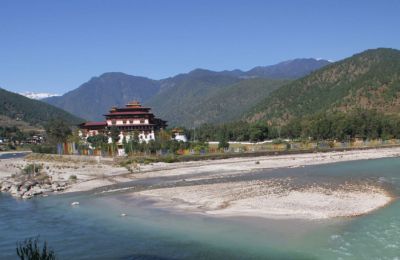
Bhutan Cultural Tour - 5 days
Bhutan Cultural Tour of 5 days lets you discover the rich Bhutanese culture. Visit ancient fortresses and Taktsang Monastery. Enjoy traditional hot stone bath.
Inquire Now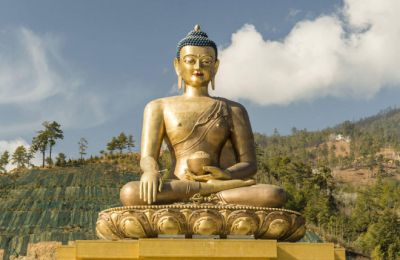
Bhutan Heritage Tour - 8 days
Bhutan Heritage Tour lets you explore centuries-old dzongs and Lakhangs built by Bhutanese kings and spiritual leaders. Take this Bhutan Heritage Tour and journey across the cultural hotspots of Bhutan, a fascinating Himalayan kingdom.
Inquire NowWhere to travel next?
Get help from our travel specialists for holiday ideas that matches your interests.
Conclusion
If Bhutan is on your bucket list, you should certainly make it a point to visit this wonderful country. While the daily tourist fee is a bit steep, the experience is well worth it. A five-day holiday will be enough to visit the major attractions in Bhutan.
For a deeper and more immersive experience, you will need an itinerary of about 10 days or more. If you intend to explore all the regions and trek through some of the popular trails, you will need to devote at least 20 days or a month to explore.
Bhutan is a unique destination, as many of its remote towns and villages have rarely been explored by outsiders.
There is so much to discover and see in this Himalayan country that one visit is not enough. So if you think as an intrepid tourist you have seen and done all and are looking for some raw experiences, then head to the Land of the Thunder Dragon.
You will be bowled over by the country's natural beauty and culture that teaches one to live in harmony with nature.
Where to travel next?
Get help from our travel specialists for holiday ideas that matches your interests.
- Written by: Naba Raj Amgai
Updated: Oct, 18, 2023

